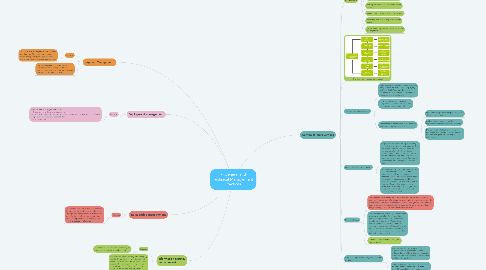
1. Information security management
1.1. Purpose
1.1.1. To protect the information needed by the organization to conduct its business.
1.2. This includes understanding and managing risks to the confidentiality, integrity, and availability of information, as well as other aspects of information security such as authentication (ensuring someone is who they claim to be) and non-repudiation (ensuring that someone can’t deny that they took an action).
2. Relationship management
2.1. Purpose
2.1.1. To establish and nurture the links between the organization and its stakeholders at strategic and tactical levels. It includes the identification, analysis, monitoring, and continual improvement of relationships with and between stakeholders.
3. Supplier Management
3.1. Purpose
3.1.1. To ensure that the organization’s suppliers and them performances are managed appropriately to support the seamless provision of quality products and services.
3.2. This includes creating closer, more collaborative relationships with key suppliers to uncover and realize new value and reduce the risk of failure.
4. Continual improvement
4.1. Purpose
4.1.1. To align the organization’s practices and services with changing business needs through the ongoing identification and improvement of services, service components, practices, or any element involved in the efficient and effective management of products and services.
4.2. Everyone’s responsibility!
4.2.1. It is important that the commitment to and practice of continual improvement is embedded into every fibre of the organization! If it is not, there is a real risk that daily operational concerns and major project work will eclipse continual improvement efforts.
4.3. Key Activities
4.3.1. encouraging continual improvement across the organization
4.3.2. securing time and budget for continual improvement
4.3.3. identifying and logging improvement opportunities
4.3.4. assessing and prioritizing improvement opportunities
4.3.5. making business cases for improvement action
4.3.6. planning and implementing improvements
4.3.7. measuring and evaluating improvement results
4.3.8. coordinating improvement activities across the organization.
4.4. The continual improvement model
4.5. Techniques and approaches
4.5.1. When assessing the current state, there are many techniques that can be employed, such as a SWOT analysis, balanced scorecard reviews, internal and external assessments and audits, etc.
4.5.2. Organizations should develop competencies in methodologies and techniques that will meet their needs.
4.5.3. Approaches to continual improvement can be found in many places, e.g.:
4.5.3.1. Lean methods provide perspectives on the elimination of waste.
4.5.3.2. Agile methods focus on making improvement incrementally at a cadence.
4.5.3.3. DevOps methods look at working holistically and ensuring improvements are not only designed well but applied effectively.
4.6. Focus but allow for innovation
4.6.1. Organizations should not try to formally commit to too many different approaches, but instead select a few key methods that are appropriate and cultivate those methods. In this way, teams will have a shared understanding of how to work together on improvements to facilitate a greater amount of change at a quicker rate.
4.6.2. At the same time, the organization should allow for innovation. Those in the organization with skills in alternative methods should be encouraged to apply them when it makes sense, and if this effort is successful, the alternate method may be added to the organization’s repertoire. Older methods may gradually be retired in favor of new ones if better results can be achieved.
4.7. Responsibilities
4.7.1. There should be at least a small team dedicated full-time to leading continual improvement efforts and advocating for the practice across the organization. This team can serve as coordinators, guides and mentors, helping others in the organization to develop the skills they need and navigating any difficulties that may be encountered.
4.7.2. The highest levels of the organization need to take responsibility for embedding continual improvement into the way that people think and work. Without their leadership and visible commitment to continual improvement, attitudes, behavior and culture will not evolve to a point where improvements are considered in everything that is done, at all levels.
4.7.3. Continual improvement is everyone’s responsibility!
4.8. Continual improvement together with third parties
4.8.1. When contracting for a supplier’s service, it is good to be sure that the contract includes details of how they will measure, report on and improve them services over the life of the contract.
4.8.2. If data will be required from suppliers to operate internal improvements, that should be specified in the contract as well.
4.9. Continual improvement register
4.9.1. To track and manage improvement ideas from identification through to final action, organizations use a database or structured document called a continual improvement register (CIR).
4.9.2. The structure of a CIR in any given organization is not important. What is important is that improvement ideas are captured, documented, assessed, prioritized, and appropriately acted upon to ensure that the organization and its services are always being improved.
4.10. Contribution to other practices
4.10.1. The continual improvement practice is integral to the development and maintenance of every other practice as well as to the complete lifecycle of all services. That said, there are some practices that make a special contribution to continual improvement, i.e.:
4.10.1.1. The organization’s problem management practice can uncover issues that will be managed through continual improvement.
4.10.1.2. The changes initiated through continual improvement may fail without the critical contributions of organizational change management.
4.10.1.3. And many improvement initiatives will use project management practices to organize and manage their execution.
5. Deployment management
5.1. Purpose
5.1.1. To move new or changed hardware, software, documentation, processes, or any other component to live environments. It may also be involved in deploying components to other environments for testing or staging.
